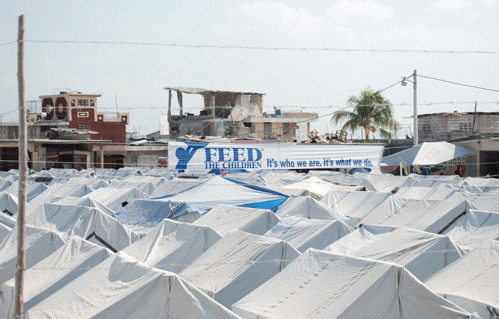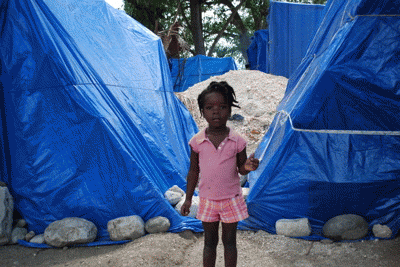For anyone who has been to Haiti and observed ground conditions there, the reasons are obvious. During the week of March 12 we were in some of the IDP camps. After a minor rainstorm floodwaters caused the overflow of pit latrines, bringing raw sewage into the camps and contaminating local water sources. This was in the camps that had pit latrines. A camp of 5,500 people near the slums of Cite Soleil had no latrines or sanitation of any sort. Feces, vomit and urine were everywhere in the surrounding bush. Obviously, contact with raw sewage greatly increases the chance of exposure to waterborne pathogens that cause diarrheal disease. Prior to the January 12th earthquake, diarrheal disease was already a leading cause of illness and death for children in Haiti. Now, children and adults are living in "shelters" that in the best conditions amount to salvaged pieces of tin providing makeshift "roofs," to tattered pieces of plastic held together with sticks. The USAID "fact sheet" about tent material would be laughable if the consequences were not so tragic.
On March 11, a USAID/OFDA flight delivered 750 rolls of plastic sheeting to Haiti. To date, USAID/OFDA has provided 15,480 rolls of plastic sheeting to meet post-earthquake shelter needs, benefiting approximately 774,000 people. The ongoing distribution of USAID/OFDA-funded plastic sheeting supports Shelter Cluster efforts to provide shelter materials to approximately 240,000 households before the likely June onset of the hurricane season.
Here is a video of what it is like to live under plastic sheeting. Imagine this scenario in the hurricane season. This video was taken on March 12, 2010.
The same "fact sheet" indicates that the United States has provided $769,948,358 in aid to Haiti. Where it has gone is anyone's guess. By the time Freedom of Information Act requests have been filed and freelance investigative journalists have done their homework, it will be too late to assist the 1.3 million estimated homeless. Infants will start dying by the thousands before the media takes note, and an outbreak of even more serious waterborne disease will likely occur.
The lies are almost frightening in the Machiavellian planning and presentation. Drive along the main roads and you will see "camps" of moderate white tents, set in orderly rows with the banners of NGOs prominently displayed. This is what you will likely see on CNN.
Take a little time to venture off the beaten path--you will not have to go far--and the reality hits you right between the eyes.
Wilson suggests that there is another area of concern that has not been examined by health officials here in the States and in Haiti.
The reason for this high level of concern is obvious to all of us who are working on the ground. An extension of that concern may be seen when considering the fragile nature of the current ad hoc medical infrastructure in the quake-affected areas. It is our assessment this infrastructure comprised mainly of volunteers is easily overwhelmed by a sudden influx of patients, particularly pediatric patients. The higher the clinical acuity, the more easily it is to overwhelm.
Dr. Wilson is being mild in his public comments. Having seen this crisis firsthand, I can assure you that it is dire. Even where a medical infrastructure exists, such as in the city of St. Marc, the hospital had no antibiotics and yet was continuing to do surgery--doctors had no options. 300 people waited in the hospital courtyard for the opportunity to see one of four rotating Haitian doctors. 500 people languished as in-patients. The administrator told our doctor that the hospital had no antibiotics. Our doctor offered his supply of medicines that will last for about a week, and pocketed a list of urgent supplies that will cost $93,000 to obtain.
Also consider Dr. Wilson's remarks that the medical "infrastructure" of Haiti consists mainly of volunteers and non-profit groups who are in a constant transitional state, and provide no continuity of care.
Amputate a leg and send someone home. To what? Fix a broken arm and send a child, homeless, to an IDP camp where there is seldom a doctor or food to be found.
We found this stash of "medical supplies" at an ad hoc camp of 2500 outside of Leogane.
This ad hoc infrastructure is both limited and easily overwhelmed. Because of these conditions, rapid identification of diarrheal disease hot spots when they emerge is critical, so that aid can be moved quickly to prevent further spread of disease and exhaustion of medical resources.
(Note: You can view every article as one long page if you sign up as an Advocate Member, or higher).







